Meng Yan
Conf-GNNRec: Quantifying and Calibrating the Prediction Confidence for GNN-based Recommendation Methods
May 22, 2025Abstract:Recommender systems based on graph neural networks perform well in tasks such as rating and ranking. However, in real-world recommendation scenarios, noise such as user misuse and malicious advertisement gradually accumulates through the message propagation mechanism. Even if existing studies mitigate their effects by reducing the noise propagation weights, the severe sparsity of the recommender system still leads to the low-weighted noisy neighbors being mistaken as meaningful information, and the prediction result obtained based on the polluted nodes is not entirely trustworthy. Therefore, it is crucial to measure the confidence of the prediction results in this highly noisy framework. Furthermore, our evaluation of the existing representative GNN-based recommendation shows that it suffers from overconfidence. Based on the above considerations, we propose a new method to quantify and calibrate the prediction confidence of GNN-based recommendations (Conf-GNNRec). Specifically, we propose a rating calibration method that dynamically adjusts excessive ratings to mitigate overconfidence based on user personalization. We also design a confidence loss function to reduce the overconfidence of negative samples and effectively improve recommendation performance. Experiments on public datasets demonstrate the validity of Conf-GNNRec in prediction confidence and recommendation performance.
QoSBERT: An Uncertainty-Aware Approach based on Pre-trained Language Models for Service Quality Prediction
May 09, 2025Abstract:Accurate prediction of Quality of Service (QoS) metrics is fundamental for selecting and managing cloud based services. Traditional QoS models rely on manual feature engineering and yield only point estimates, offering no insight into the confidence of their predictions. In this paper, we propose QoSBERT, the first framework that reformulates QoS prediction as a semantic regression task based on pre trained language models. Unlike previous approaches relying on sparse numerical features, QoSBERT automatically encodes user service metadata into natural language descriptions, enabling deep semantic understanding. Furthermore, we integrate a Monte Carlo Dropout based uncertainty estimation module, allowing for trustworthy and risk-aware service quality prediction, which is crucial yet underexplored in existing QoS models. QoSBERT applies attentive pooling over contextualized embeddings and a lightweight multilayer perceptron regressor, fine tuned jointly to minimize absolute error. We further exploit the resulting uncertainty estimates to select high quality training samples, improving robustness in low resource settings. On standard QoS benchmark datasets, QoSBERT achieves an average reduction of 11.7% in MAE and 6.7% in RMSE for response time prediction, and 6.9% in MAE for throughput prediction compared to the strongest baselines, while providing well calibrated confidence intervals for robust and trustworthy service quality estimation. Our approach not only advances the accuracy of service quality prediction but also delivers reliable uncertainty quantification, paving the way for more trustworthy, data driven service selection and optimization.
CoSIL: Software Issue Localization via LLM-Driven Code Repository Graph Searching
Mar 28, 2025



Abstract:Large language models (LLMs) have significantly advanced autonomous software engineering, leading to a growing number of software engineering agents that assist developers in automatic program repair. Issue localization forms the basis for accurate patch generation. However, because of limitations caused by the context window length of LLMs, existing issue localization methods face challenges in balancing concise yet effective contexts and adequately comprehensive search spaces. In this paper, we introduce CoSIL, an LLM driven, simple yet powerful function level issue localization method without training or indexing. CoSIL reduces the search space through module call graphs, iteratively searches the function call graph to obtain relevant contexts, and uses context pruning to control the search direction and manage contexts effectively. Importantly, the call graph is dynamically constructed by the LLM during search, eliminating the need for pre-parsing. Experiment results demonstrate that CoSIL achieves a Top-1 localization success rate of 43 percent and 44.6 percent on SWE bench Lite and SWE bench Verified, respectively, using Qwen2.5 Coder 32B, outperforming existing methods by 8.6 to 98.2 percent. When CoSIL is applied to guide the patch generation stage, the resolved rate further improves by 9.3 to 31.5 percent.
TruthSR: Trustworthy Sequential Recommender Systems via User-generated Multimodal Content
Apr 26, 2024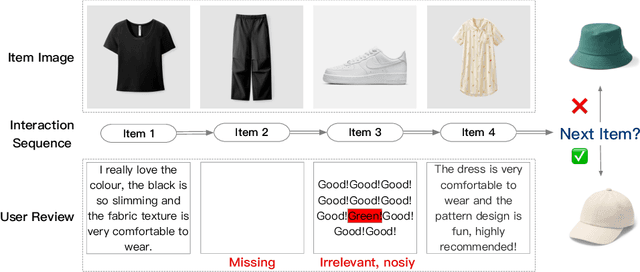

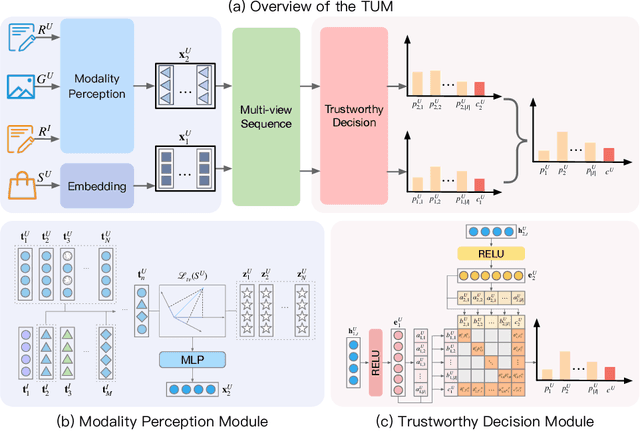
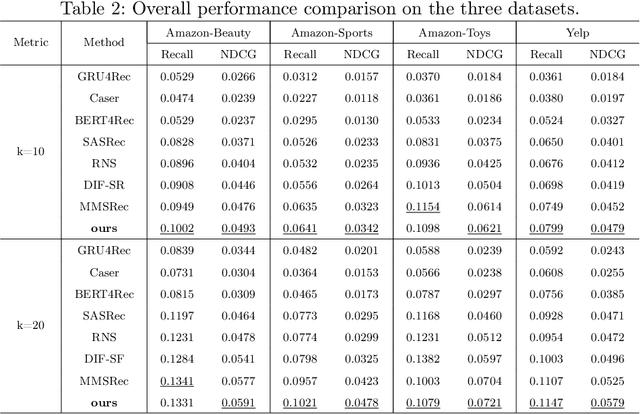
Abstract:Sequential recommender systems explore users' preferences and behavioral patterns from their historically generated data. Recently, researchers aim to improve sequential recommendation by utilizing massive user-generated multi-modal content, such as reviews, images, etc. This content often contains inevitable noise. Some studies attempt to reduce noise interference by suppressing cross-modal inconsistent information. However, they could potentially constrain the capturing of personalized user preferences. In addition, it is almost impossible to entirely eliminate noise in diverse user-generated multi-modal content. To solve these problems, we propose a trustworthy sequential recommendation method via noisy user-generated multi-modal content. Specifically, we explicitly capture the consistency and complementarity of user-generated multi-modal content to mitigate noise interference. We also achieve the modeling of the user's multi-modal sequential preferences. In addition, we design a trustworthy decision mechanism that integrates subjective user perspective and objective item perspective to dynamically evaluate the uncertainty of prediction results. Experimental evaluation on four widely-used datasets demonstrates the superior performance of our model compared to state-of-the-art methods. The code is released at https://github.com/FairyMeng/TrustSR.
A Dual Latent State Learning Approach: Exploiting Regional Network Similarities for QoS Prediction
Oct 07, 2023



Abstract:Individual objects, whether users or services, within a specific region often exhibit similar network states due to their shared origin from the same city or autonomous system (AS). Despite this regional network similarity, many existing techniques overlook its potential, resulting in subpar performance arising from challenges such as data sparsity and label imbalance. In this paper, we introduce the regional-based dual latent state learning network(R2SL), a novel deep learning framework designed to overcome the pitfalls of traditional individual object-based prediction techniques in Quality of Service (QoS) prediction. Unlike its predecessors, R2SL captures the nuances of regional network behavior by deriving two distinct regional network latent states: the city-network latent state and the AS-network latent state. These states are constructed utilizing aggregated data from common regions rather than individual object data. Furthermore, R2SL adopts an enhanced Huber loss function that adjusts its linear loss component, providing a remedy for prevalent label imbalance issues. To cap off the prediction process, a multi-scale perception network is leveraged to interpret the integrated feature map, a fusion of regional network latent features and other pertinent information, ultimately accomplishing the QoS prediction. Through rigorous testing on real-world QoS datasets, R2SL demonstrates superior performance compared to prevailing state-of-the-art methods. Our R2SL approach ushers in an innovative avenue for precise QoS predictions by fully harnessing the regional network similarities inherent in objects.
Probabilistic Deep Supervision Network: A Noise-Resilient Approach for QoS Prediction
Aug 03, 2023



Abstract:Quality of Service (QoS) prediction is an essential task in recommendation systems, where accurately predicting unknown QoS values can improve user satisfaction. However, existing QoS prediction techniques may perform poorly in the presence of noise data, such as fake location information or virtual gateways. In this paper, we propose the Probabilistic Deep Supervision Network (PDS-Net), a novel framework for QoS prediction that addresses this issue. PDS-Net utilizes a Gaussian-based probabilistic space to supervise intermediate layers and learns probability spaces for both known features and true labels. Moreover, PDS-Net employs a condition-based multitasking loss function to identify objects with noise data and applies supervision directly to deep features sampled from the probability space by optimizing the Kullback-Leibler distance between the probability space of these objects and the real-label probability space. Thus, PDS-Net effectively reduces errors resulting from the propagation of corrupted data, leading to more accurate QoS predictions. Experimental evaluations on two real-world QoS datasets demonstrate that the proposed PDS-Net outperforms state-of-the-art baselines, validating the effectiveness of our approach.
Plot2API: Recommending Graphic API from Plot via Semantic Parsing Guided Neural Network
Apr 02, 2021



Abstract:Plot-based Graphic API recommendation (Plot2API) is an unstudied but meaningful issue, which has several important applications in the context of software engineering and data visualization, such as the plotting guidance of the beginner, graphic API correlation analysis, and code conversion for plotting. Plot2API is a very challenging task, since each plot is often associated with multiple APIs and the appearances of the graphics drawn by the same API can be extremely varied due to the different settings of the parameters. Additionally, the samples of different APIs also suffer from extremely imbalanced. Considering the lack of technologies in Plot2API, we present a novel deep multi-task learning approach named Semantic Parsing Guided Neural Network (SPGNN) which translates the Plot2API issue as a multi-label image classification and an image semantic parsing tasks for the solution. In SPGNN, the recently advanced Convolutional Neural Network (CNN) named EfficientNet is employed as the backbone network for API recommendation. Meanwhile, a semantic parsing module is complemented to exploit the semantic relevant visual information in feature learning and eliminate the appearance-relevant visual information which may confuse the visual-information-based API recommendation. Moreover, the recent data augmentation technique named random erasing is also applied for alleviating the imbalance of API categories. We collect plots with the graphic APIs used to drawn them from Stack Overflow, and release three new Plot2API datasets corresponding to the graphic APIs of R and Python programming languages for evaluating the effectiveness of Plot2API techniques. Extensive experimental results not only demonstrate the superiority of our method over the recent deep learning baselines but also show the practicability of our method in the recommendation of graphic APIs.
A Probability Distribution and Location-aware ResNet Approach for QoS Prediction
Nov 16, 2020



Abstract:In recent years, the number of online services has grown rapidly, invoke the required services through the cloud platform has become the primary trend. How to help users choose and recommend high-quality services among huge amounts of unused services has become a hot issue in research. Among the existing QoS prediction methods, the collaborative filtering(CF) method can only learn low-dimensional linear characteristics, and its effect is limited by sparse data. Although existing deep learning methods could capture high-dimensional nonlinear features better, most of them only use the single feature of identity, and the problem of network deepening gradient disappearance is serious, so the effect of QoS prediction is unsatisfactory. To address these problems, we propose an advanced probability distribution and location-aware ResNet approach for QoS Prediction(PLRes). This approach considers the historical invocations probability distribution and location characteristics of users and services, and first use the ResNet in QoS prediction to reuses the features, which alleviates the problems of gradient disappearance and model degradation. A series of experiments are conducted on a real-world web service dataset WS-DREAM. The results indicate that PLRes model is effective for QoS prediction and at the density of 5%-30%, which means the data is sparse, it significantly outperforms a state-of-the-art approach LDCF by 12.35%-15.37% in terms of MAE.
A Novel Automation-Assisted Cervical Cancer Reading Method Based on Convolutional Neural Network
Dec 14, 2019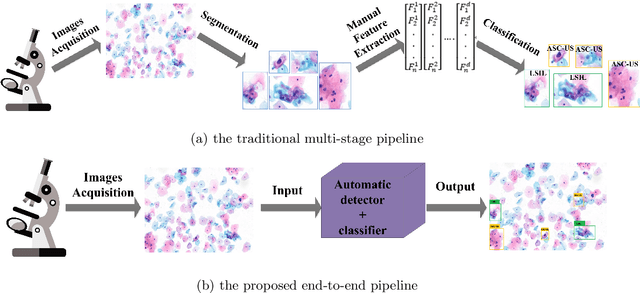

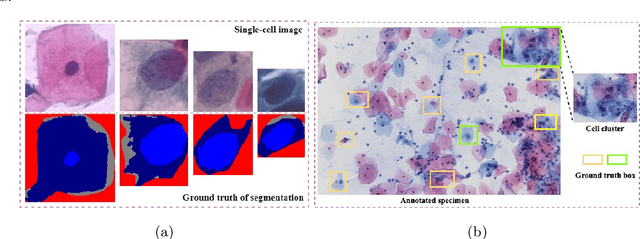

Abstract:While most previous automation-assisted reading methods can improve efficiency, their performance often relies on the success of accurate cell segmentation and hand-craft feature extraction. This paper presents an efficient and totally segmentation-free method for automated cervical cell screening that utilizes modern object detector to directly detect cervical cells or clumps, without the design of specific hand-crafted feature. Specifically, we use the state-of-the-art CNN-based object detection methods, YOLOv3, as our baseline model. In order to improve the classification performance of hard examples which are four highly similar categories, we cascade an additional task-specific classifier. We also investigate the presence of unreliable annotations and cope with them by smoothing the distribution of noisy labels. We comprehensively evaluate our methods on test set which is consisted of 1,014 annotated cervical cell images with size of 4000*3000 and complex cellular situation corresponding to 10 categories. Our model achieves 97.5% sensitivity (Sens) and 67.8% specificity (Spec) on cervical cell image-level screening. Moreover, we obtain a mean Average Precision (mAP) of 63.4% on cervical cell-level diagnosis, and improve the Average Precision (AP) of hard examples which are valuable but difficult to distinguish. Our automation-assisted cervical cell reading method not only achieves cervical cell image-level classification but also provides more detailed location and category information of abnormal cells. The results indicate feasible performance of our method, together with the efficiency and robustness, providing a new idea for future development of computer-assisted reading system in clinical cervical screening.
Efficient Misalignment-Robust Multi-Focus Microscopical Images Fusion
Dec 21, 2018

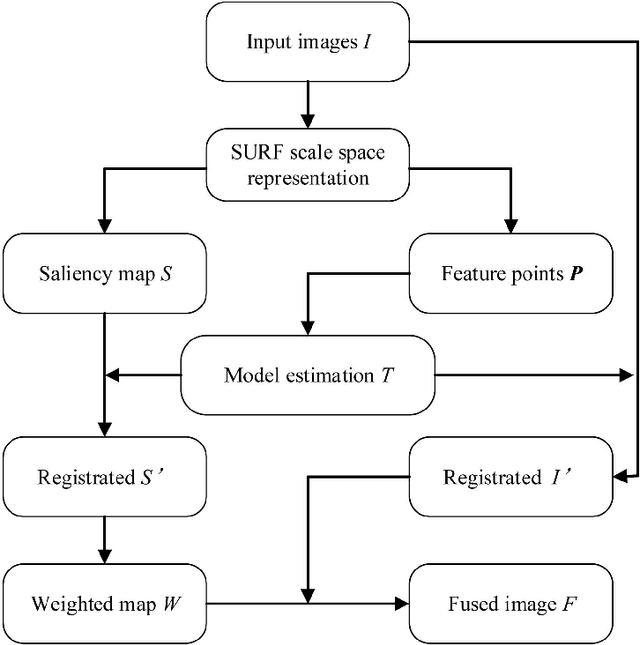

Abstract:In this paper we propose a very efficient method to fuse the unregistered multi-focus microscopical images based on the speed-up robust features (SURF). Our method follows the pipeline of first registration and then fusion. However, instead of treating the registration and fusion as two completely independent stage, we propose to reuse the determinant of the approximate Hessian generated in SURF detection stage as the corresponding salient response for the final image fusion, thus it enables nearly cost-free saliency map generation. In addition, due to the adoption of SURF scale space representation, our method can generate scale-invariant saliency map which is desired for scale-invariant image fusion. We present an extensive evaluation on the dataset consisting of several groups of unregistered multi-focus 4K ultra HD microscopic images with size of 4112 x 3008. Compared with the state-of-the-art multi-focus image fusion methods, our method is much faster and achieve better results in the visual performance. Our method provides a flexible and efficient way to integrate complementary and redundant information from multiple multi-focus ultra HD unregistered images into a fused image that contains better description than any of the individual input images. Code is available at https://github.com/yiqingmy/JointRF.
 Add to Chrome
Add to Chrome Add to Firefox
Add to Firefox Add to Edge
Add to Edge